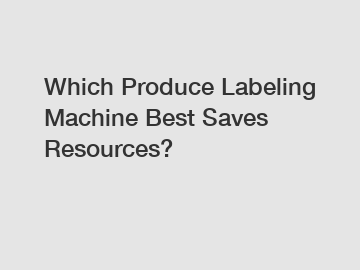Which Produce Labeling Machine Best Saves Resources?
Which Produce Labeling Machine Best Saves Resources?
In today's world, where sustainability is more important than ever, finding ways to reduce waste and save resources is paramount. One area that can make a significant impact is the labeling process in the produce industry. Choosing a produce labeling machine that is efficient and minimizes resource usage can help companies lower their environmental footprint while also improving productivity. In this article, we will explore different types of produce labeling machines and analyze which one best saves resources.
1. Direct Thermal Labeling Machines.

Direct thermal labeling machines use heat-sensitive paper to print labels. The labels are created by applying heat to the paper, causing the image or text to appear. These machines do not require ink or toner, making them an environmentally friendly option. They eliminate the need for ink cartridges or ribbons, reducing waste and saving resources.
These machines are also highly efficient and time-saving. With direct thermal printing, labels can be printed quickly, improving productivity. Additionally, the lack of ink or toner means less maintenance and fewer consumables to manage.
2. Inkjet Labeling Machines.
Inkjet labeling machines, as the name suggests, use inkjet technology to print labels. They are generally more versatile than direct thermal machines, allowing for high-resolution printing with various colors. However, they do require ink cartridges, which can add to waste and resource consumption.
To minimize the environmental impact of inkjet labeling machines, it is important to choose models with features that optimize ink usage. Some machines have advanced algorithms that can precisely distribute ink for optimal coverage, reducing the amount of ink needed for each label. By reducing ink waste, these machines can help save resources and lower costs.
3. Laser Labeling Machines.
Laser technology is another option for produce labeling. Laser labeling machines use a laser beam to etch or mark labels onto the surface of the produce. This process does not require any consumables like ink or toner, making it a highly sustainable choice.
Laser labeling machines offer exceptional precision and are capable of high-speed production. They also have the advantage of producing permanent labels that are resistant to smudging, fading, or rubbing off. However, they may not be suitable for all types of produce, as some surfaces may not be conducive to laser marking.
In conclusion, when considering which produce labeling machine best saves resources, the choice between a direct thermal, inkjet, or laser machine depends on various factors. Direct thermal machines are a standout option for their inkless printing technology, resulting in minimal waste and resource usage. Inkjet machines can still be a viable choice if equipped with features that optimize ink consumption. Laser machines, while sustainable in terms of consumables, may have limitations in terms of compatibility with certain surfaces.
Regardless of the type of machine chosen, it is essential to consider other factors such as efficiency, productivity, and label quality. Investing in a labeling machine that minimizes waste and resource consumption can contribute to a more sustainable produce industry.
For more information or to explore our range of produce labeling machines, please contact us. Join us in taking a step towards a greener future while optimizing your labeling process.
If you are looking for more details, kindly visit Wholesale Auto Label Machine, pcb buffer, CE Loader Unloader.

Comments